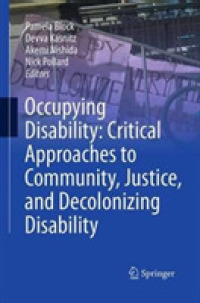Full Description
Forensic anthropology is a vastly popular and rapidly changing profession, yet to date there has been no volume that reflects the current state of the discipline and forecasts its future. The first comprehensive text in the field, Forensic Anthropology: Contemporary Theory and Practice examines the medical, legal, ethical, and humanitarian issues associated with forensic anthropology, current forensic methods, and bio-historical investigations.
Forensic Anthropology offers a unique synthesis of theoretical and methodological coverage. Rather than simply describing methodology, Komar and Buikstra place forensic anthropology in the broader context of medico-legal death investigations, critically evaluating practical techniques in a scientific framework and detailing the anthropologist's role in relation to both law enforcement and the medical examiner or coroner. The authors review the current state of the field, emphasizing recent changes to the judicial guidelines regarding the admissibility of scientific evidence in court. They highlight the impact of these rulings, the increased need for scientific rigor, and the evolving nature of anthropological studies, preparing students to function effectively in the demanding judicial system that will evaluate their work in the future. The text also stresses the vital importance of research in the development of forensic applications of anthropology.
Forensic Anthropology is enhanced by numerous illustrative case studies and more than ninety photos and illustrations that help to deepen and enrich students' understanding of the material. Coauthored by a top authority in forensic anthropology and an anthropologist whose fieldwork has included medico-legal death investigation in Bosnia, Kosovo, Iraq, and Darfur, this volume is an in-depth and indispensable guide to the dynamic and rapidly professionalizing field of forensic anthropology.
Contents
CHAPTERS 2-10 OPEN WITH AN INTRODUCTION AND END WITH A CONCLUSION. ; 1. INTRODUCTION ; Forensic Anthropology: A Brief History (1972-2006) ; What Is Forensic Anthropology Today? ; Where Do Forensic Anthropologists Work? ; Is Forensic Anthropology Expanding in the United States? ; Forensic Anthropology Outside the United States ; Research in Forensic Anthropology Today ; Forensic Anthropology in Perspective ; 2. THE MEDICOLEGAL SYSTEM ; The Medicolegal System ; Jurisdiction ; Cause and Manner of Death ; Autopsy and Postmortem Examinations ; 3. EVIDENCE AND THE JUDICIAL SYSTEM ; Evidence ; Evidence Interpretation: Rationality versus Parsimony ; The Judicial System: An Overview ; Testifying as a Witness ; Homicide ; 4. CRIME SCENE INVESTIGATION: IDENTIFYING MEDICOLEGAL REMAINS, SEARCH STRATEGIES, AND SCENE DOCUMENTATION ; Identifying Remains of Medicolegal Significance ; Differentiating Human from Animal Bone and Nonbiological Materials ; Jurisdiction and the Crime Scene ; Evaluating Scenes ; Search Strategies ; Evidence ; Documentation ; Burials ; Report Writing ; 5. BEGINNING THE IDENTIFICATION PROCESS: DEVELOPING A BIOLOGICAL PROFILE ; Theories and Methods in Forensic Anthropology ; The Estimation of Sex from Skeletal Remains ; The Estimation of Age-at-Death from Skeletal Remains ; Ancestry ; Stature Estimation ; Other Physical Features ; 6. PATHOLOGY AND TRAUMA ASSESSMENT ; The Language of Pathology, Anatomy, and Medicine ; Pathology: An Overview ; Trauma Assessment ; Gunshot Wound Interpretation ; 7. FORENSIC TAPHONOMY ; Forensic Taphonomy ; The Goals of Forensic Taphonomy ; 8. PERSONAL IDENTIFICATION ; How Identification Is Established ; Categories of Identification ; Methods of Positive Identification ; Alternative Medical Imaging ; Impact of Daubert on Positive Identification ; Photographic Superimposition and Facial Recognition ; 9. MASS DEATH AND INTERNATIONAL INVESTIGATIONS OF HUMAN RIGHTS VIOLATIONS ; War Crimes ; Personal Identification ; Humanitarian versus Medicolegal Response ; Mass Graves ; Objectivity ; 10. BIOHISTORY: HISTORICAL QUESTIONS, METHODS, AND ETHICS ; Biohistory: Past and Present ; Noninvasive Analyses ; A Case Study in Biohistorical and Forensic Investigation: Billy the Kid ; Glossary ; References Cited and Related Bibliographic Items ; Index

![Poema Alexandri Pope De Homine, Jacobi Thomson [The Hymn From the Seasons], & Thomae Gray Selecta Carmina, in Lat. Linguam Tr. a J. Costa. Cum Nonnull](../images/goods/../parts/goods-list/no-phooto.jpg)






